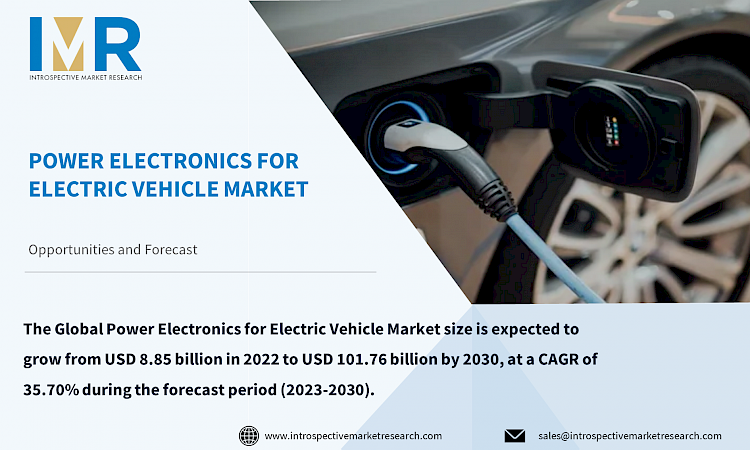Market Overview:
The Global Power Electronics for Electric Vehicle Market size is expected to grow from USD 8.85 billion in 2022 to USD 101.76 billion by 2030, at a CAGR of 35.70% during the forecast period (2023-2030).
Power electronics play a vital role in the functioning of electric vehicles as they are responsible for converting and managing the electric power supply within the system. These components, such as onboard chargers, converters, and inverters, enable efficient operations at high voltage or current levels due to their fast switching rate and improved efficiency. They also ensure the regulation of energy flow in both directions, allowing for the return of regenerated energy to the utility grid. Power electronics are essential in various applications to optimize energy management by facilitating the conversion for motor operation, battery storage, and generator usage. In maritime applications, the demand for highly reliable power converters with simplified maintenance requirements is increasing due to the intricate electrical designs involved.
Top Key Players Covered In The Power Electronics for Electric Vehicle Market:
- Denso Corporation (Japan)
- Robert Bosch GmbH (Germany)
- Infineon Technologies AG (Germany)
- Delphi Technologies (United Kingdom)
- Continental AG (Germany)
- Hitachi Automotive Systems Ltd. (Japan)
- Valeo (France)
- Mitsubishi Electric Corporation (Japan)
- Hella (Germany)
- Panasonic Corporation (Japan)
- Tesla Inc. (United States)
- Toyota Industries Corporation (Japan)
- Hangzhou Tiecheng Information Technology (China) And Other Major Players.
Market Dynamics and Factors:
The progress and advancements in energy-efficient electric vehicles serve as a significant driving force for the power electronics market in the electric vehicle industry. As electric vehicles continue to gain popularity and become a viable alternative to traditional combustion engine vehicles, the demand for more efficient and reliable power electronics components increases. Energy efficiency is a key factor in the development of electric vehicles, as it directly impacts the driving range and overall performance. Power electronics play a crucial role in optimizing energy flow and conversion within electric vehicles. They enable efficient power management, voltage regulation, and energy conversion between the battery, motor, and other electrical systems. Advancements in power electronics technology have led to improved efficiency, reduced power losses, and enhanced performance of electric vehicles.
The development of high-performance semiconductors specifically designed for electric vehicle (EV) power electronics presents a significant opportunity within the Power Electronics for Electric Vehicle Market. This opportunity arises from the need to continually improve the efficiency, power density, and reliability of power electronic systems in electric vehicles. High-performance semiconductors, such as wide-bandgap (WBG) materials like silicon carbide (SiC) and gallium nitride (GaN), offer advantages over traditional silicon-based devices.
The Power Electronics for Electric Vehicle Market Report Highlight:
- By Application, the Inverter segment is anticipated to lead the growth of the Power Electronics for Electric Vehicle Market in the forecasted timeframe. As electric vehicles rely on power electronics for their efficient operation, inverters play a crucial role in converting the DC (direct current) power from the battery into AC (alternating current) power required for the electric motor.
- By End – Use, The Railway segment is expected to dominate the Power Electronics for Electric Vehicle Market. Because it plays a crucial role in enhancing the efficiency and performance of electric rail systems. They enable efficient energy conversion, regenerative braking, and power management, resulting in improved overall system performance, reduced energy consumption, and extended range.
- The Asia-Pacific is predicted to grow significantly in Power Electronics for Electric Vehicle Market. The Asia-Pacific region, particularly countries like China, Japan, and South Korea, has witnessed substantial growth in the electric vehicle market.
Key Industry Development:
- In September 2023, Infineon Technologies Launched its CoolSiC MOSFET Gen5 series, boasting 30% lower switching losses and higher efficiency compared to previous generations. This translates to extended battery range and faster charging times for EVs.
- In February 2023, Rohm Semiconductor Unveiled its SiC Schottky Barrier Diodes with industry-leading low leakage current and reverse recovery charge.
Power Electronics for Electric Vehicle Market Segmentation:
By Application
- Inverter
- Converter
- On-board Charger
By End-Use
- Automotive
- Railways
- Marine
- Electrically Powered Airborne Vehicles
For this report, Introspective Market Research has segmented the Power Electronics for Electric Vehicle Market based on region:
Regional Outlook (Revenue in USD Million; Volume in Units, 2022-2028)
North America
- The U.S.
- Canada
- Mexico
Eastern Europe
- Russia
- Bulgaria
- The Czech Republic
- Hungary
- Poland
- Romania
- Rest of Eastern Europe
Western Europe
- Germany
- UK
- France
- Netherlands
- Italy
- Spain
- Rest of Western Europe
Asia Pacific
- China
- India
- Japan
- Singapore
- Australia
- New-Zealand
- Rest of APAC
Middle East & Africa
- Turkey
- Saudi Arabia
- Qatar
- UAE
- Israel
- South Africa
South America
- Brazil
- Argentina
- Rest of SA





